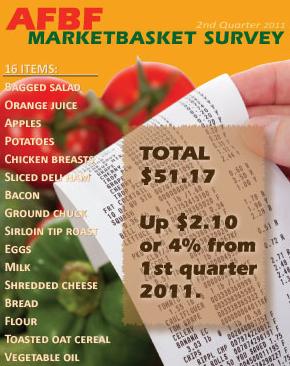Energy Cost Run-up Drives Retail Food Prices in Second Quarter
By American Farm Bureau Federation,
WASHINGTON, D.C., June 9, 2011 – Retail food prices at the supermarket increased during the second quarter of 2011, according to the latest American Farm Bureau Federation Marketbasket Survey. The informal survey shows the total cost of 16 food items that can be used to prepare one or more meals was $51.17, up $2.10 or about 4 percent compared to the first quarter of 2011. Of the 16 items surveyed, 14 increased and two decreased in average price compared to the prior quarter. The total average price for the 16 items was up about 8 percent compared to one year ago.

“The effects of continued raw energy cost increases are reverberating throughout the food industry and consumers are bearing the brunt of it,” said AFBF Economist John Anderson. “After food leaves the farm, costs for transportation, marketing, processing and storage come into play. As energy prices continue to run up, shoppers are feeling the pinch at the supermarket.”
Sirloin tip roast, Russet potatoes, sliced deli ham and bacon increased the most in dollar value compared to the first quarter of 2011. Together, these four items accounted for most of the quarter-to-quarter increase: sirloin tip roast, up 52 cents to $4.48 per pound; Russet potatoes, up 43 cents to $3.07 for a 5-pound bag; sliced deli ham, up 35 cents to $5.26 per pound; and bacon, up 32 cents to $4.18 per pound.
“Strong consumer demand for meats and dairy products continues to influence retail prices,” said Anderson. “Consumer demand for meats and dairy products began to recover in 2009, continued through 2010 and is still a factor as we move into the middle of 2011.”
Other items that increased in price compared to the first quarter were ground chuck, up 19 cents to $3.29 per pound; whole milk, up 16 cents to $3.62 per gallon; vegetable oil, up 13 cents to $3.01 for a 32-ounce bottle; toasted oat cereal, up 12 cents to $3.17 for a 9-ounce box; apples, up 11 cents to $1.56 per pound; orange juice, up 4 cents to $3.18 for a half-gallon; eggs, up 3 cents to $1.65 per dozen; bread, up 2 cents to $1.86 for a 20-ounce loaf; bagged salad, up 1 cent to $2.67 per pound; and flour, up 1 cent to $2.52 for a 5-pound bag.
Two items decreased in average retail price between the quarters: boneless chicken breasts, down 23 cents to $3.09 per pound; and shredded cheese, down 7 cents to $4.56 per pound.
Most items showing an increase in retail price from quarter-to-quarter also showed year-to-year increases. Compared to one year ago, Russet potatoes increased 22 percent; bacon rose 18 percent; ground chuck was up 14 percent; and sirloin tip roast was 9 percent higher.
“Further retail price increases are likely to be the new normal as we move through 2011, especially for meats. It takes time for farmers to increase the size of their herds to in order to meet higher demand,” Anderson explained.
The year-to-year direction of the marketbasket survey tracks with the federal government’s Consumer Price Index (www.bls.gov/cpi) report for food at home. As retail grocery prices have increased gradually over time, the share of the average food dollar that America’s farm and ranch families receive has dropped.
“In the mid-1970s, farmers received about one-third of consumer retail food expenditures for food eaten at home and away from home, on average. Since then, that figure has decreased steadily and is now about 16 percent, according to the Agriculture Department’s revised Food Dollar Series,” Anderson said. USDA’s new Food Dollar Series may be found online at http://www.ers.usda.gov/Data/FoodDollar/app/.
Using the “food at home and away from home” percentage across-the-board, the farmer’s share of this quarter’s $51.17 marketbasket would be $8.19.
AFBF, the nation’s largest general farm organization, has been conducting the informal quarterly marketbasket survey of retail food price trends since 1989. The mix of foods in the marketbasket was updated during the first quarter of 2008.
According to USDA, Americans spend just under 10 percent of their disposable annual income on food, the lowest average of any country in the world. A total of 72 shoppers in 30 states participated in the latest survey, conducted in May.
-30-
Sidebar: Tracking Milk and Egg Trends
For the second quarter of 2011, shoppers reported the average price for a half-gallon of regular whole milk was $2.31, up 6 cents from the prior quarter. The average price for one gallon of regular whole milk was $3.62, up 16 cents. Comparing per-quart prices, the retail price for whole milk sold in gallon containers was about 25 percent lower compared to half-gallon containers, a typical volume discount long employed by retailers.
The average price for a half-gallon of rBST-free milk was $3.18, down 5 cents from the last quarter, about 40 percent higher than the reported retail price for a half-gallon of regular milk ($2.31).
The average price for a half-gallon of organic milk was $3.77, up 7cents compared to the prior quarter – about 60 percent higher than the reported retail price for a half-gallon of regular milk ($2.31).
Compared to a year ago (second quarter of 2010), the retail price for regular milk in gallon containers was up about 18 percent while regular milk in half-gallon containers rose 12 percent. The average retail price for rBST-free milk increased 6 percent compared to the prior year while organic milk was up about 3 percent.
For the second quarter of 2011, the average price for one dozen regular eggs was $1.65. The average price for a dozen “cage-free” eggs was $3.20, nearly double the price of regular eggs. Compared to a year ago (second quarter of 2010), regular eggs decreased 7 percent while “cage-free” eggs increased 10 percent.
Disclaimer: Articles featured on Oregon Report are the creation, responsibility and opinion of the authoring individual or organization which is featured at the top of every article.


